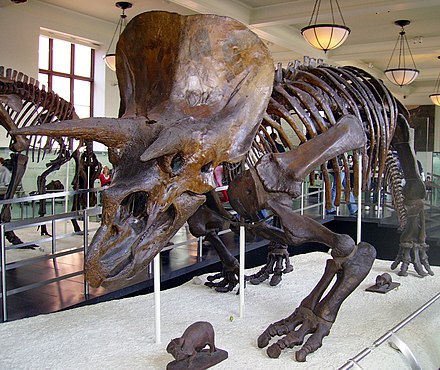Torosaurus
Torosaurus ("perforated lizard", in reference to the large openings in its frill) is a genus of herbivorous ceratopsid dinosaur that lived during the late Maastrichtian stage of the Cretaceous period, between 68 and 66 million years ago, though it is possible that the species range might extend to as far as 69 million years ago.[1] Fossils have been discovered across the Western Interior of North America, from Saskatchewan to southern Texas.
Torosaurus possessed one of the largest skulls of any known land animal. The frilled skull reached up to 2.77 metres (9.1 ft) in length. From head to tail, Torosaurus is thought to have measured about 8 to 9 m (26 to 30 ft) long[2][3] and weighed eight to twelve tonnes. Torosaurus is distinguished from the contemporary Triceratops by an elongate frill with large openings (fenestrae), long squamosal bones of the frill with a trough on their upper surface, and the presence of five or more pairs of hornlets (epoccipitals) on the back of the frill.[4] Torosaurus also lacked the long nose horn seen in Triceratops prorsus, and instead resembled the earlier and more basal Triceratops horridus in having a short nose horn.[4] Three species have been named, Torosaurus latus, T. gladius and T. utahensis. T. gladius is no longer considered a valid species, however.
In 2010, the validity of Torosaurus was disputed.[5] A study of fossil bone histology combined with an investigation of frill shape concluded that Torosaurus probably represented the mature form of Triceratops, with the bones of typical Triceratops specimens still immature and showing signs of a first development of distinct Torosaurus frill holes. During maturation, the skull frill would have been greatly lengthened and holes would have appeared in it.[6][7][8] In 2011, 2012 and 2013 however, studies of external features of known specimens have claimed that morphological differences between the two genera preclude their synonymy. The main problems are a lack of good transitional forms, the apparent existence of authentic Torosaurus subadults, different skull proportions independent of maturation, and hole formation at an adult stage not being part of a normal ceratopsian maturation sequence.[4][9][10] Consequently, it is still debated whether Torosaurus truly is an adult Triceratops or a separate genus.
In 1891, two years after the naming of Triceratops, a pair of ceratopsian skulls with elongated frills bearing holes were found in southeastern Wyoming, Niobrara County, by John Bell Hatcher. Hatcher's employer, paleontologist Professor Othniel Charles Marsh, coined the genus Torosaurus for them.[11]
The name Torosaurus is frequently translated as "bull lizard" from the Latin noun taurus or Spanish toro but much more likely is derived from the Greek verb τορέω (toreo, "to pierce, perforate").[12] The allusion is to the fenestrae or ("window-like") holes in the elongated frill, which have traditionally served to distinguish it from the solid frill of Triceratops. Much of the confusion over etymology of the name results from the fact that Marsh never explicitly explained it in his papers.


.jpg/440px-Torosaurus_(23547625914).jpg)

